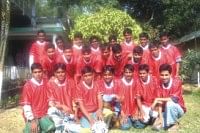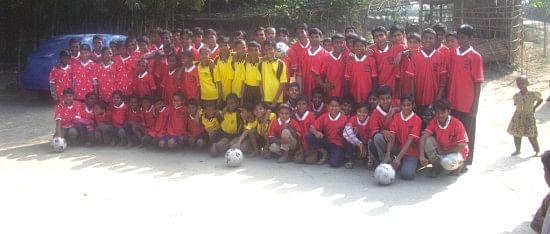| Endeavour
The Richest Village on Earth
Muhit Rahman
 It might not seem an unusual sight anywhere in small town, America. Picture a bunch of pre-teen boys in bright Indian Hill red jerseys (Indian hill is a suburb of Cincinnati, Ohio, USA) battling their counterparts in equally bright Georgetown gold (another suburb of Cincinnati) over a soccer ball on a wide open field. Urgent shouts and calls fill the crisp morning air and a handful of supporters cheer heartily from the sidelines as the ball repeatedly shoots way up in the air. It might not seem an unusual sight anywhere in small town, America. Picture a bunch of pre-teen boys in bright Indian Hill red jerseys (Indian hill is a suburb of Cincinnati, Ohio, USA) battling their counterparts in equally bright Georgetown gold (another suburb of Cincinnati) over a soccer ball on a wide open field. Urgent shouts and calls fill the crisp morning air and a handful of supporters cheer heartily from the sidelines as the ball repeatedly shoots way up in the air.
But something is odd. Indian Hill and Georgetown play in different youth soccer leagues and the two teams do not play each other during the regular season. Even during the tournaments the two teams never meet. And look again, some other things appear unusual as well!
 For starters, it is January, which is way too late for fall soccer and equally early for spring soccer around Ohio. And these kids, they are playing with no shoes on! Even with global warming and everything, January is way too cold for no shoes. Look closer and the field looks different. No snow on the ground and no grass either. Just clumps of evenly spaced golden yellow stalks sticking out a few of inches from the ground. If one knew better, one might think that it looked a lot like a recently harvested rice field in Bangladesh! Strange shouts fill the air and the excited chatter is most definitely not English. “Oi, Oi, Oi! becky koi, becky koi?” comes the plaintive cry from an out of place half-back as an opposing forward races past him with the ball. For starters, it is January, which is way too late for fall soccer and equally early for spring soccer around Ohio. And these kids, they are playing with no shoes on! Even with global warming and everything, January is way too cold for no shoes. Look closer and the field looks different. No snow on the ground and no grass either. Just clumps of evenly spaced golden yellow stalks sticking out a few of inches from the ground. If one knew better, one might think that it looked a lot like a recently harvested rice field in Bangladesh! Strange shouts fill the air and the excited chatter is most definitely not English. “Oi, Oi, Oi! becky koi, becky koi?” comes the plaintive cry from an out of place half-back as an opposing forward races past him with the ball.
***
It all started about two years ago when I caught my wife trying to throw away nine perfectly fine, beautiful red jerseys that had accumulated from my three children's participation in the local recreational soccer league.
“You are not going to throw those away? I asked indignantly.
“Well, what am I supposed to do with them? They no longer fit!” my wife replied.
She had a point. Although used just for a few games and practically new, these soccer jerseys are rendered just about useless once a child joins a different team and is assigned a different number the next season. League rules are very particular about wearing only the assigned number and even if the number problem was somehow solved, most kids do not fit into their uniforms from the previous year. So an idea was born. “We'll recycle them” I said, and my wife shook her head and retrieved the jerseys from the discard pile.
I swung into action. The local youth soccer league is run by the Indian Hill Recreation Commission and they thought that giving the jerseys a second life was a great idea. Most Americans (but by no means all!) are by nature charitable, and the idea of helping less fortunate youngsters resonated strongly. Besides, it would free up landfill space! So in collaboration with my charity that is dedicated towards helping Bangladesh, the Recreation Commission organised a drive that encouraged parents and children to donate unneeded jerseys at the end of the season for redistribution half a world away. Collection bins were placed in the village offices (Indian Hill, although one of the most prosperous localities in the US, is self-designated a 'village' as a nod to its quaint, country charm) and coaches volunteered to pick up and deliver. The primary, elementary and middle schools soon got into the act and announcements were sent home and additional collection bins were set up in each school.
And the jerseys started trickling in. First there were a couple and then a few more and then they really started coming. By early November, bins were overflowing all over
the place and cardboard boxes had to be pressed into service. Everyone, it seemed, had a used uniform to donate. Shirts of every size and colour showed up from closets around town. And there were a lot of donations from folks who just stopped by. Among the unusual donations were twenty plus sets of purple and white basketball uniforms from the Lakers (I didn't even know that there were Lakers in Cincinnati!) and an array of baseball jackets and uniforms from the Empress Chili and Cincinnati Pride. A couple of counties over, the folks at Georgetown (named after one US president and the birthplace of another) got wind of the affair and decided to get into the act. It seems that Georgetown too had a surfeit of used uniforms. Soon four boxes of Georgetown gold joined the rest of the uniforms in my basement where they were carefully sorted, and cataloged. (Only a few needed to be laundered first!) The adjacent township of Madeira does recycle its uniforms but found over a hundred sets that it no longer needed. In neighbouring Wyoming, the recreation commission got into full swing and more collection bins worked around the clock. A scant few months later, the bulk of the jerseys were being distributed to poor children in villages in northern Bangladesh. Counting the shirts and the pants separately, a total of 734 articles of clothing were collected the first year and many, many more than that the second.
***
In the village of Bharatkhali where the mosque and the railway station have both fallen into the river (the mosque has been rebuilt but the trains are long gone) the Bangladesh Relief Fund supports a K-4 school for really poor children. The Fatima School was scraped together from funds and material leftover from building sanitary latrines in the village. The Scandinavian charity that had funded the sanitary latrines, once they got over the shock that there were funds left over, were only too pleased to accept the suggestion that a small school be built with the excess funds. But the grant to build the latrines was a one-time deal and when that project ended, the school had no operating funds. This is where I stepped in. My charity, the Bangladesh Relief Fund provides a little under $100 per month to provide for the three teachers and other support staff who oversee the education of about 80 young children who have limited other recourse. But many of the children were ashamed to come to school because their clothes were too tattered. Thanks to the generosity of the children of Indian Hill they got school uniforms. On the day the uniforms were distributed, the little courtyard was full of screaming, smiling children thrilled to wear the nicest shirt that most of them had ever owned.
Some 50 or so miles to the west, the village of Dolla is filled with the offspring of the folks that my grandfather left behind when he left the village some eighty years ago for life in the big cities. The children there aren't quite as poor as those in the Fatima School in Bharatkhali but most of them could never afford a soccer ball much less a soccer uniform. But like children all over the world, they love playing soccer. Right around December, word spread that bright red uniforms might be coming to town.
On a fine morning in early January, six teams of 11 players each had lined up neatly behind their team captains in front of my ancestral family home in Dolla. They were waiting patiently for me and my eight year old daughter, Nadia to arrive from Bharatkhali. It was a crisp January day, a bit on the cold side but no one was thinking about leaving his post. Around noon, a little white Toyota carrying us negotiated the last bump in the dirt road leading into the heart of the village and a loud cheer rose from the waiting teams and their nearby fans. There was barely controlled chaos as each team lined up to introduce themselves and receive their almost new uniforms. Five of the teams got Indian Hill Soccer uniforms and one got outfitted in Georgetown gold. Each pair of teams also received a brand new soccer ball.
Less than an hour later, Georgetown was playing Indian Hill for the village boasting rights. It was a defensive duel as the ball ricocheted crazily off the clumps of rice stalks left over from the harvest. The ball would travel straight as long as it was in the air but as soon as it hit the ground, all bets were off. But judging by the hoots and hollers and the sheer noise level, no one seemed to mind. It seemed right that Indian Hill got lucky and scored the only goal. But looking at them you'd think that they were all winners. And if a smile is worth a million dollars, for just that day, Dolla was the richest village on earth.
Postscript: Earlier this year, 'soccer kits' consisting of two sets of jerseys and a soccer ball were distributed to dozens of high schools and primary schools in Birampur, Rangpur and Manikganj. More are being distributed as this story goes to print.
The writer is a non-resident Bangladeshi

Copyright
(R) thedailystar.net 2007 |
